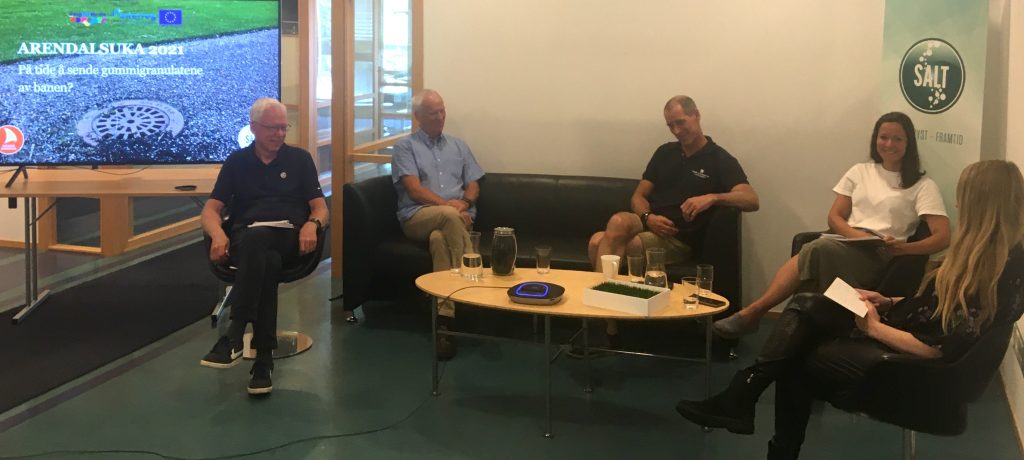Is it time to send rubber granules ‘off the field’?
The Norwegian consultancy company SALT, which is one of the partners in the project FanpLESStic-Sea, works with and studies microplastic pollution from artificial soccer turfs.
 There are 2,000 artificial turfs in Norway and calculations show that they pollute with about 19,000 tons of rubber granules every single year. Rubber granules are the next largest source of pollution to primary microplastics in the country, second to wear and tear from our roads and car tires. SALT organized a debate in August 2021 during “Arendal-week” where the question was “Is it time to send rubber granules ‘off the field’?”
There are 2,000 artificial turfs in Norway and calculations show that they pollute with about 19,000 tons of rubber granules every single year. Rubber granules are the next largest source of pollution to primary microplastics in the country, second to wear and tear from our roads and car tires. SALT organized a debate in August 2021 during “Arendal-week” where the question was “Is it time to send rubber granules ‘off the field’?”

Bjørn Aas, from NTNU, the Norwergian University of Science and Technology, is a scientist studying artificial turfs. He started out the debate with information about rubber granules and how they are not only a pollution problem but also have carcinogens that neither children nor adults should encounter. Aas presented some alternatives to rubber granulate which included sand, bark and olive pits and explained how these alternatives are feasible options and are already available today. When planning for a turf, owners consider cost-efficiency and therefore usually go with rubber granulate as their material of choice. If maintenance costs were included in calculating costs, then both organic materials and sand would be the more cost-effective choice, says Bjørn Aas.
During the debate Ole Myhrvold, from the Football Association of Norway, pointed out that it is important that the fill material maintains a sufficiently high quality. Rubber granules have shown that they are a material that works well, while other types of fill have varied in their results. Bærum county officials have decided that they will not build any more artificial turfs with rubber granulate. Nils Bergseng who works with sports facilities within the municipality, explained that they are currently doing tests of different types of artificial turfs: one with no fill, one with fill of olive pits, and one with sand fill. The feedback that they have received so far shows that children under 16 years of age are happy with all of the turfs while adults say that the turf with no fill is too thin.
Synnøve Kvamme is Vice President of the Nature Conservation Association. She was very clear in her opinion, that the use of rubber granules need to be eliminated. The measures that have been taken so far to prevent rubber migration from the fields, do not work. She is also concerned with the health risks associated with rubber granules and that children are in such close contact with it. Even if we cannot prove that exposure to this material is dangerous, we should be prepared for potential problems in the future.
Malin Jacob, from SALT, who lead the debate concluded with a question to the participants: “When should rubber granules be excluded from turfs?” Both the scientist, Aas from NTNU and the Nature Conservation Association want to exclude rubber granules immediately while the Bærum municipality says that rubber is in the ‘final overtime period’. The Football Association of Norway does not want to see a ban on the use of rubber granules, but believes that there will be no new turfs built with rubber in 10 years’ time.
